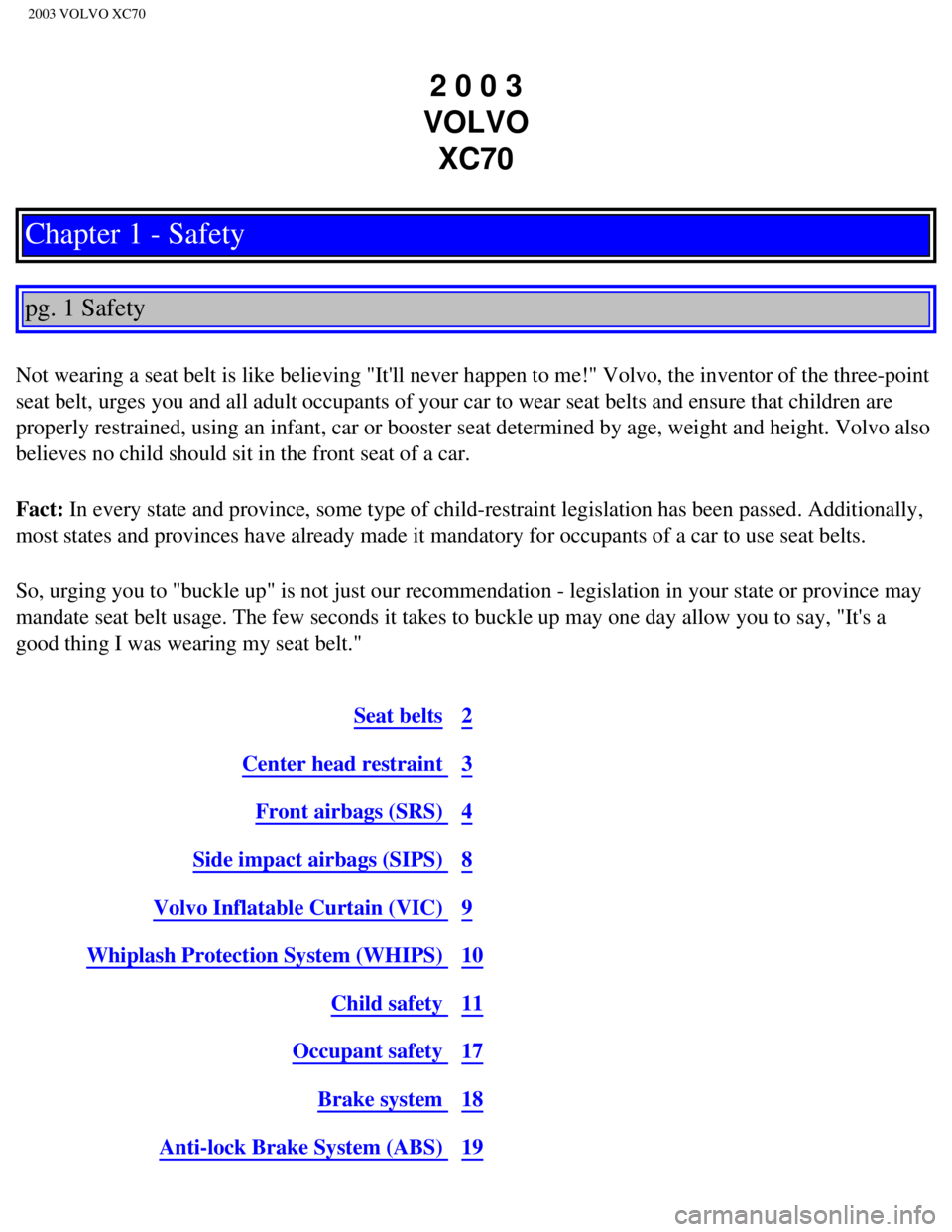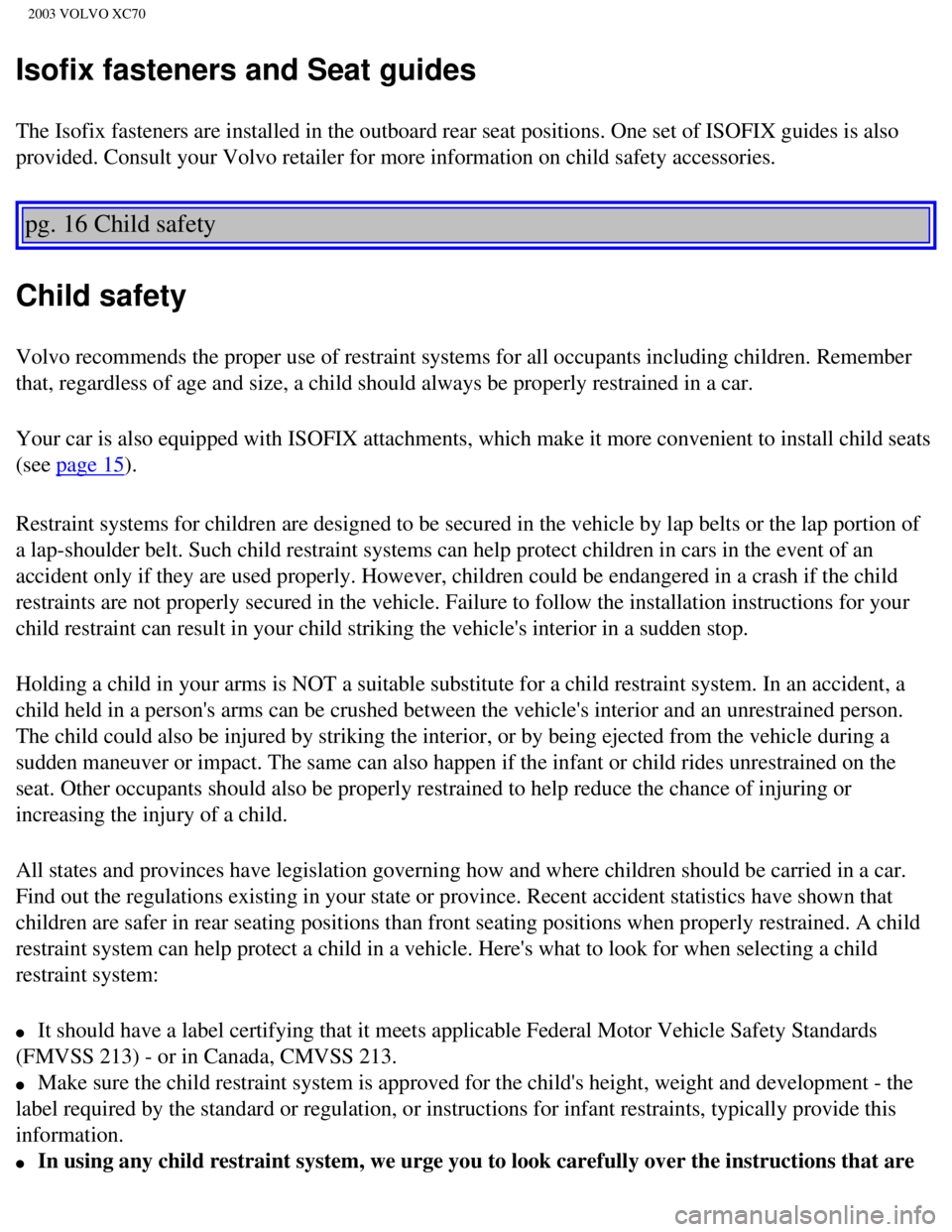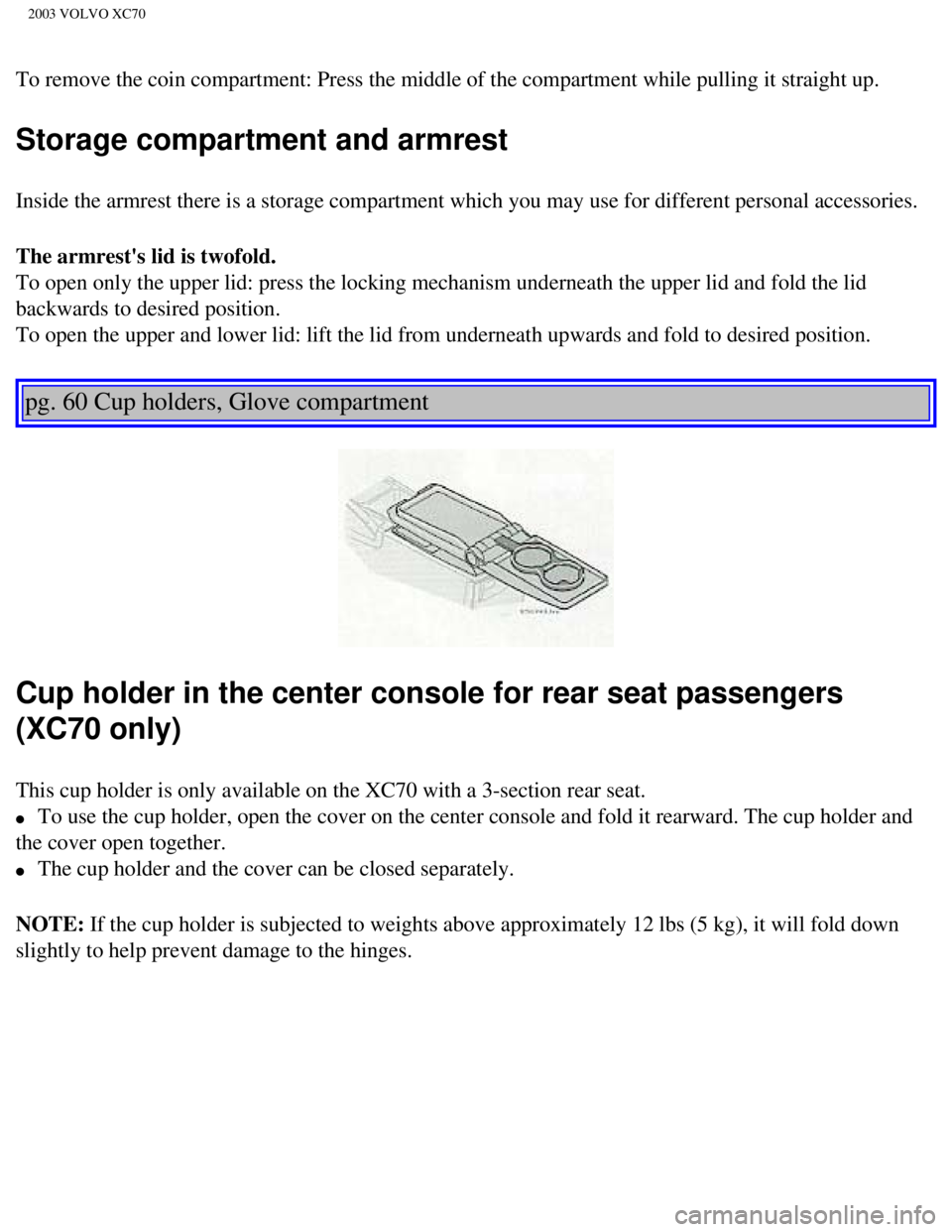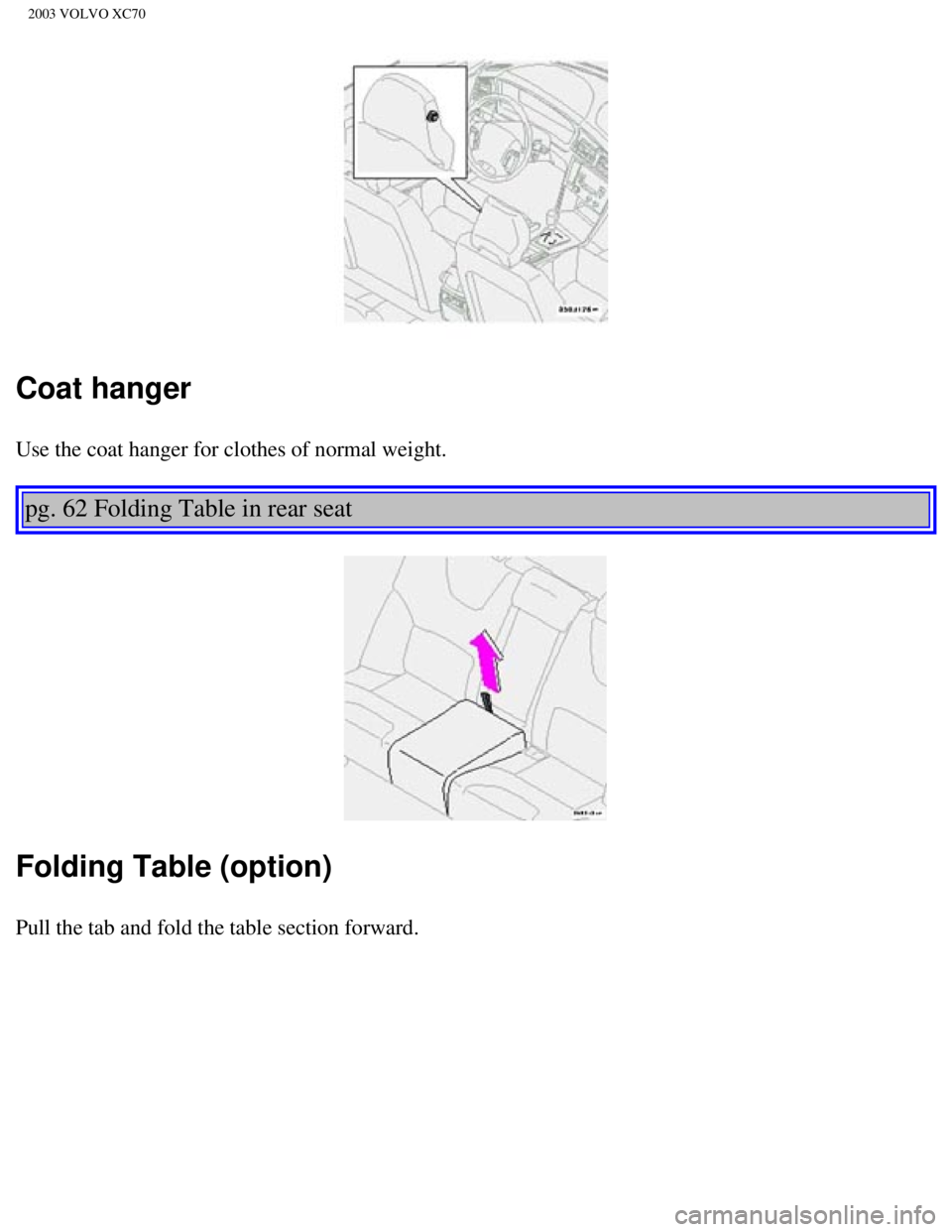2003 VOLVO XC70 weight
[x] Cancel search: weightPage 5 of 257

2003 VOLVO XC70
Volvo's environmental activities are based on a holistic view, which mea\
ns we consider the overall
environmental impact of a product throughout its complete life cycle. In\
this context, design, production,
product use, and recycling are all important considerations.
In production, Volvo has partly or completely phased out several chemica\
ls including freons, lead
chromates, naphtanates, asbestos, mercury and cadmium; and reduced the a\
mount of chemicals used in
our plants 50% since 1991.
In use, Volvo was the first in the world to introduce into production a \
three-way catalytic converter with
a Lambda sond, now called oxygen sensor, in 1976. The current version of\
this highly efficient system
reduces emissions of harmful substances (CO, HC, NOx) from the exhaust\
pipe by approximately 95%
and the search to eliminate the remaining emissions continues. Volvo is \
the only automobile
manufacturer to offer CFC-free retrofit kits for the air conditioning sy\
stem for all models as far back as
the M/Y 1975 240. Advanced electronic engine controls, refined purificat\
ion systems and cleaner fuels
are bringing us closer to our goal.
After Volvo cars and parts have fulfilled their use, recycling is the ne\
xt critical step in completing the
life cycle. The metal content is about 75% of the total weight of a car,\
which makes the car among the
most recycled industrial products. In order to have efficient and well c\
ontrolled recycling, many Volvo
variants have printed dismantling manuals, indicating the weight and mat\
erial of individual components.
For Volvo, all homogeneous plastic parts weighing more than 1.7 oz. (50\
grams) are marked with
international symbols that indicate how the component is to be sorted fo\
r recycling.
In addition to continuous environmental refinement of conventional gasol\
ine-powered internal
combustion engines, Volvo is actively looking at advanced technology alt\
ernative-fuel vehicles.
When you drive a Volvo, you become our partner in the work to lessen the\
car's impact on the
environment.
To reduce your vehicle's environmental impact, you can:
l Maintain proper air pressure in your tires. Tests have shown decreased f\
uel economy with improperly
inflated tires
l Follow the recommended maintenance schedule
l Drive at a constant speed
l See an authorized Volvo retailer as soon as possible for inspection if t\
he check engine (malfunction
indicator) lamp illuminates, or stays on after the vehicle has started \
l Properly dispose of any vehicle related waste such as used motor oil, us\
ed batteries, brake pads, etc.
l When cleaning your car, use Volvo's own car care products, all of which \
have systematically been
adapted to the environment
PremAir®
file:///K|/ownersdocs/2003/2003_XC70/03xc70_00.htm (5 of 6)12/30/2006 \
4:17:50 PM
Page 7 of 257

2003 VOLVO XC70
2 0 0 3
VOLVO XC70
Chapter 1 - Safety
pg. 1 Safety
Not wearing a seat belt is like believing "It'll never happen to me!" Vo\
lvo, the inventor of the three-point
seat belt, urges you and all adult occupants of your car to wear seat be\
lts and ensure that children are
properly restrained, using an infant, car or booster seat determined by \
age, weight and height. Volvo also
believes no child should sit in the front seat of a car.
Fact: In every state and province, some type of child-restraint legislation h\
as been passed. Additionally,
most states and provinces have already made it mandatory for occupants o\
f a car to use seat belts.
So, urging you to "buckle up" is not just our recommendation - legislati\
on in your state or province may
mandate seat belt usage. The few seconds it takes to buckle up may one d\
ay allow you to say, "It's a
good thing I was wearing my seat belt."
Seat belts2
Center head restraint 3
Front airbags (SRS) 4
Side impact airbags (SIPS) 8
Volvo Inflatable Curtain (VIC) 9
Whiplash Protection System (WHIPS) 10
Child safety 11
Occupant safety 17
Brake system 18
Anti-lock Brake System (ABS) 19
file:///K|/ownersdocs/2003/2003_XC70/03xc70_01a.htm (1 of 17)12/30/200\
6 4:17:51 PM
Page 30 of 257

2003 VOLVO XC70
Isofix fasteners and Seat guides
The Isofix fasteners are installed in the outboard rear seat positions. \
One set of ISOFIX guides is also
provided. Consult your Volvo retailer for more information on child safe\
ty accessories.
pg. 16 Child safety
Child safety
Volvo recommends the proper use of restraint systems for all occupants i\
ncluding children. Remember
that, regardless of age and size, a child should always be properly rest\
rained in a car.
Your car is also equipped with ISOFIX attachments, which make it more co\
nvenient to install child seats
(see
page 15).
Restraint systems for children are designed to be secured in the vehicle\
by lap belts or the lap portion of
a lap-shoulder belt. Such child restraint systems can help protect child\
ren in cars in the event of an
accident only if they are used properly. However, children could be enda\
ngered in a crash if the child
restraints are not properly secured in the vehicle. Failure to follow th\
e installation instructions for your
child restraint can result in your child striking the vehicle's interior\
in a sudden stop.
Holding a child in your arms is NOT a suitable substitute for a child re\
straint system. In an accident, a
child held in a person's arms can be crushed between the vehicle's inter\
ior and an unrestrained person.
The child could also be injured by striking the interior, or by being ej\
ected from the vehicle during a
sudden maneuver or impact. The same can also happen if the infant or chi\
ld rides unrestrained on the
seat. Other occupants should also be properly restrained to help reduce \
the chance of injuring or
increasing the injury of a child.
All states and provinces have legislation governing how and where childr\
en should be carried in a car.
Find out the regulations existing in your state or province. Recent acci\
dent statistics have shown that
children are safer in rear seating positions than front seating position\
s when properly restrained. A child
restraint system can help protect a child in a vehicle. Here's what to l\
ook for when selecting a child
restraint system:
l It should have a label certifying that it meets applicable Federal Motor\
Vehicle Safety Standards
(FMVSS 213) - or in Canada, CMVSS 213.
l Make sure the child restraint system is approved for the child's height,\
weight and development - the
label required by the standard or regulation, or instructions for infant\
restraints, typically provide this
information.
l In using any child restraint system, we urge you to look carefully over \
the instructions that are
file:///K|/ownersdocs/2003/2003_XC70/03xc70_01b.htm (7 of 14)12/30/200\
6 4:17:52 PM
Page 88 of 257

2003 VOLVO XC70
To remove the coin compartment: Press the middle of the compartment whil\
e pulling it straight up.
Storage compartment and armrest
Inside the armrest there is a storage compartment which you may use for \
different personal accessories.
The armrest's lid is twofold.
To open only the upper lid: press the locking mechanism underneath the u\
pper lid and fold the lid
backwards to desired position.
To open the upper and lower lid: lift the lid from underneath upwards an\
d fold to desired position.
pg. 60 Cup holders, Glove compartment
Cup holder in the center console for rear seat passengers
(XC70 only)
This cup holder is only available on the XC70 with a 3-section rear seat\
.
l To use the cup holder, open the cover on the center console and fold it \
rearward. The cup holder and
the cover open together.
l The cup holder and the cover can be closed separately.
NOTE: If the cup holder is subjected to weights above approximately 12 lbs (\
5 kg), it will fold down
slightly to help prevent damage to the hinges.
file:///K|/ownersdocs/2003/2003_XC70/03xc70_04a.htm (8 of 11)12/30/200\
6 4:17:56 PM
Page 90 of 257

2003 VOLVO XC70
Coat hanger
Use the coat hanger for clothes of normal weight.
pg. 62 Folding Table in rear seat
Folding Table (option)
Pull the tab and fold the table section forward.
file:///K|/ownersdocs/2003/2003_XC70/03xc70_04a.htm (10 of 11)12/30/20\
06 4:17:56 PM
Page 140 of 257

2003 VOLVO XC70
lower with the air conditioning on and the windows closed than with the \
air conditioning off and the
windows open.
l Using the onboard trip computer's fuel consumption modes can help you le\
arn how to drive more
economically.
Other factors that decrease gas mileage are:
l Dirty air cleaner
l Dirty engine oil and clogged oil filter
l Dragging brakes
l Incorrect front end alignment Some of the above mentioned items and othe\
rs are checked at the
standard Maintenance Service intervals.
NOTE: Vehicles equipped with automatic transmissions should use (D)rive as o\
ften as possible and
avoid using "kick-down" to help improve fuel economy. Vehicles equipped \
with manual transmissions
should use fifth gear at highway speeds. At other times, choose the high\
est gear that still allows smooth
acceleration.
Weight distribution affects handling
At the specified curb weight your car has a tendency to understeer, whic\
h means that the steering wheel
has to be turned more than might seem appropriate for the curvature of a\
bend. This ensures good
stability and reduces the risk of rear wheel skid. Remember that these p\
roperties can alter with the
vehicle load. The heavier the load on the rear of the vehicle (e.g., he\
avily loaded (max. 220 lbs, 100 kg)
cargo area or when towing a trailer, the less the tendency to understeer\
.
Handling, roadholding
Vehicle load, tire design and inflation pressure all affect vehicle hand\
ling. Therefore, check that the tires
are inflated to the recommended pressure according to the vehicle load. \
See "Tire pressure" section.
Loads should be distributed so that capacity weight or maximum permissib\
le axle loads are not
exceeded.
pg. 96 Points to remember
Cooling system
The risk for engine overheating is greatest, especially in hot weather, \
when:
l Towing a trailer up steep inclines for prolonged periods at wide open th\
rottle and low engine rpm.
l Stopping the engine suddenly after high speed driving (so-called "after\
-boiling" can occur).
l To avoid overheating, the following rules should be followed: Do not dri\
ve for prolonged periods at
file:///K|/ownersdocs/2003/2003_XC70/03xc70_06a.htm (17 of 22)12/30/20\
06 4:18:00 PM
Page 142 of 257

2003 VOLVO XC70
Electrical system
When replacing the battery or when carrying out work involving the elect\
rical system, the following
should be observed:
l A battery connection to the wrong terminal will damage the electrical sy\
stem. Be sure to connect the
positive battery cable to the positive battery terminal and the negative\
battery cable to the negative
battery terminal.
l If booster batteries are used for starting, they must be properly connec\
ted to minimize the risk of the
electrical system being damaged. For correct connection, see "Jump start\
ing" section.
l Never disconnect the battery circuit (for example, to replace the batte\
ry) while the engine is running,
as this may damage the generator. Always make sure that all the battery \
connections are properly
cleaned and tightened.
l If any electrical welding work is performed on the vehicle, the battery'\
s ground lead (negative cable)
and all the connecting cables of the generator must be disconnected and \
the welder cables placed as near
the welding points as possible.
l The radio must be turned off before the battery is disconnected.
l Switch off the ignition for at least 10 minutes before disconnecting the\
battery.
pg. 97 Roof racks/Load carriers
Load carriers (accessory)
Load carriers are available as Volvo accessories. Observe the following \
points when in use:
l To avoid damaging your car and to achieve maximum safety when driving, w\
e recommend using the
load carriers that Volvo has developed especially for your car.
l Volvo-approved removable roof racks are designed to carry the maximum al\
lowable roof load for this
vehicle: 220 lbs (100 kg). For Non-Volvo roof racks, check the manufac\
turer's weight limits for the rack.
l Never exceed the rack manufacturer's weigh limits and never exceed the m\
aximum rated roof load of
220 lbs (100 kg).
l Avoid single-point loads. Distribute loads evenly.
l Place heavier cargo at the bottom of the load.
l Anchor the cargo correctly with appropriate tie-down equipment.
l Check periodically that the load carriers and load are properly secured.\
l Remember that the car's center of gravity and handling change when you c\
arry a load on the roof.
l The car's wind resistance (and correspondingly, fuel consumption) will\
increase with the size of the
load.
l Drive smoothly. Avoid rapid starts, fast cornering and hard braking.
file:///K|/ownersdocs/2003/2003_XC70/03xc70_06a.htm (19 of 22)12/30/20\
06 4:18:00 PM
Page 149 of 257

2003 VOLVO XC70
pg. 101 Towing a trailer
When preparing for trailer towing, observe the following:
Volvo recommends the use of Volvo trailer hitches which are specially de\
signed for the car.
l Maximum trailer weight recommended by Volvo is:
Trailers without brakes: 1100 lbs (500 kg)
Trailers with brakes: 3300 lbs* (1,500 kg),
Observe the legal requirements of the state/province in which the vehicl\
es are registered.
l All Volvo models are equipped with energy-absorbing shock-mounted bumper\
s. Trailer hitch
installation should not interfere with the proper operation of this bump\
er system.
Trailer towing does not normally present any particular problems, but ta\
ke into consideration:
l Increase tire pressure to recommended full. See section "Wheels and tire\
s".
l When your car is new, avoid towing heavy trailers during the first 620 m\
iles (1000 km).
l Recommended hitch tongue load is:
Trailer weights below 2,650 lbs (1,200 kg) - 110 lbs (50 kg)
Trailer weights above 2,650 lbs (1,200 kg) - 165 lbs (75 kg)
l Maximum speed when towing a trailer: 50 mph (80 km/h).
l Engine and transmission are subject to increased loads. Therefore, engin\
e coolant temperature should
be closely watched when driving in hot climates or hilly terrain. Use a \
lower gear and turn off the air
conditioner if the temperature gauge needle enters the red range.
l If the automatic transmission begins to overheat, a message will be disp\
layed in the text window.
l Avoid overload and other abusive operation.
l Hauling a trailer affects handling, durability, and economy.
l It is necessary to balance trailer brakes with the towing vehicle brakes\
to provide a safe stop (check
and observe state/local regulations).
l Do not connect the trailer's brake system directly to the vehicle's brak\
e system.
l More frequent vehicle maintenance is required.
l Remove the ball and drawbar assembly when the hitch is not being used.
l Volvo recommends the use of synthetic engine oil when towing a trailer o\
ver long distances or in
mountainous areas.
file:///K|/ownersdocs/2003/2003_XC70/03xc70_06b.htm (4 of 10)12/30/200\
6 4:18:00 PM